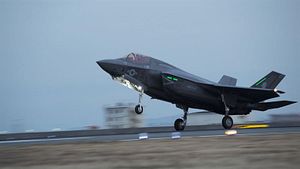The latest breach in the F-35 program has come out of Australia, where a subcontractor reportedly lost unclassified data on the fighter (and the P-8 maritime patrol aircraft) to a sophisticated hacking operation. The Australian government does not seem overly concerned about the incident, and the data does not apparently disclose anything particularly critical about the program. Nevertheless, the breach illustrates the new reality of how military technology spreads around the world.
States have always had to worry about the theft of their military technology through espionage. States have also long understood the tensions between exporting military technology and maintaining a technological edge. Any weapon sold to a customer, or built in combination with a partner, has the potential to expose fundamental weaknesses or technologies to opponents. States resolve this problem by refraining from selling their most advanced tech, or by placing severe restrictions on the handling of that technology. The United States famously acquired numerous copies of Soviet MiG fighters from former Soviet trade partners, to give one example of how the process can fail.
Unfortunately, increasingly severe problems of technology management are baked into the modern defense industrial cake. While defense industries were historically slow to adapt to the trans-national turn in corporate capitalism, in recent decades they have decisively moved in the direction of greater integration. Indeed, the development of a globally integrated system of technology transfer has sometime been cited as one of the causes for the massive advantage that Western technology enjoyed over its Eastern bloc counterpart towards the end of the Cold War. This process has only accelerated as defense budgets have declined, forcing national defense giants into collaboration with one another.
The F-35 offers an object lesson in this regard. In order to generate sales, the United States developed an industrial plan that involved an array of international partners, divided into tiers based on their level of technology cooperation. The governments involved would be able to tell their constituents that they were bringing home jobs and technology, while also acquiring the world’s most advanced fighter. This has led to a dizzying array of subcontractors around the world, unfortunately accompanied by few strong constraints on cyber-hygiene. Thus, attackers can acquire pieces of the F-35 puzzle not simply by hacking the U.S. Department of Defense or Lockheed Martin, but also by breaking into small companies that have access to data on the production of the fighter.
Autarky has its merits. China and Russia both enjoy some advantages, largely because neither country has extensive defense production partnerships with other countries. Even this may be changing, however. The joint production of the JF-17 fighter between China and Pakistan has necessitated the development of an extensive industrial relationship, even as Pakistan maintains significant military ties with the United States. Fortunately for China, the JF-17 is hardly at the cutting edge of global aerospace technology.
More concerning, Russia continues to attempt to work out the details of joint production of the Su-57 stealth fighter with India. Russia has also made overtures towards Finland to engage in some downstream defense technology integration, although Finnish industry has yet to embrace such a program. The Russian defense industry has also suffered from the Soviet legacy, in that components built in the erstwhile USSR are no longer available at the same cost (or at all) for Russian production.
We can only imagine what might happen if a recalcitrant U.S. ally (say, Turkey or Israel) decided to re-export an F-35 to Russia or China. On the upside, the Russians and Chinese already likely know what they need to about the U.S. aircraft. But there is no question that the developing structure of the global defense industry has made the objective of maintaining U.S. technological supremacy more difficult.
































